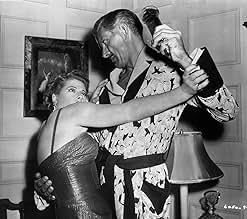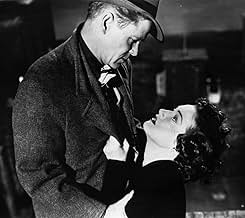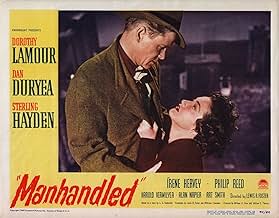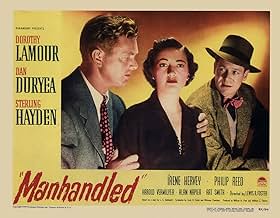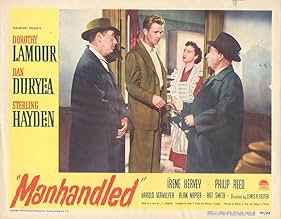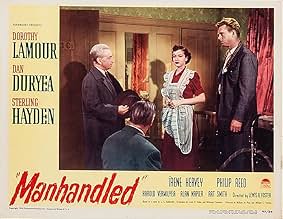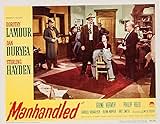Ajouter une intrigue dans votre langueThe secretary to a psychiatrist finds herself caught up in the murder of a patient's wife and realizes that her life is also in danger.The secretary to a psychiatrist finds herself caught up in the murder of a patient's wife and realizes that her life is also in danger.The secretary to a psychiatrist finds herself caught up in the murder of a patient's wife and realizes that her life is also in danger.
- Réalisation
- Scénario
- Casting principal
Stanley Blystone
- Cop
- (non crédité)
Paul E. Burns
- Pawn Shop Owner
- (non crédité)
James Edwards
- Henry, Bennet's Butler
- (non crédité)
Morgan Farley
- Doc, Police Lab Man
- (non crédité)
John George
- Newspaper Vendor
- (non crédité)
George Humbert
- Italian Restaurant Owner
- (non crédité)
Ray Hyke
- Detective Phil Wilson
- (non crédité)
Donald Kerr
- Reporter
- (non crédité)
Avis à la une
... makes this film. Paramount made another film with the exact same name 25 years before, but it was a Gloria Swanson film very much of its time, and this is a film very much of its time - the film noir cycle. And the title is a bit bewildering since "manhandling" really has nothing to do with the plot.
The film opens with psychiatrist Dr. Redman listening to his patient, Alton Bennett (Alan Napier) , talking about a troubling recurring dream he has in which he murders his wealthy and wayward wife, Ruth (Irene Harvey). The doctor advises Bennett to sleep in the guest bedroom for a few nights if he is afraid of what he might do. He then tells his secretary, Merl (Dorothy Lamour), to return that night because he wants to tell Mrs. Bennett all about what her husband just said. Patient-doctor confidentiality isn't what it used to be apparently.
The most catching of Mrs. Bennett's possessions are a bunch of jewels that she owns that are worth and insured for one hundred thousand dollars. After the doctor tells Mrs. Bennett about her husband's dream, she blows it off basically telling the doctor that her husband is harmless. But the next day she is found murdered in her apartment and the jewels are missing.
There are plenty of suspects besides the husband. For one, the secretary Merl has some kind of secret past, and she has only been working for the doctor for four weeks. Her downstairs neighbor, a PI and ex-cop (Duryea) seems up to no good, and Ruth Bennett told her latest boyfriend about the husband's threat and he seems surprised and fascinated when she also tells him that the jewels are authentic - he thought they were fake. Who knows what other people Ruth might have told about the jewels or who these people that we know about might have told.
There are plenty of twists in this one, and who actually did it is a surprise, but it is a bit of a mystery that Duryea is third billed since he is the person you notice, whose character jumps off the screen at you. Lamour and even Sterling Hayden, whose big break will come the following year in Asphalt Jungle, and are both billed above Duryea, seem a bit two dimensional in this. It is really a plot driven noir.
Paramount didn't do very many noirs, but the ones they did do were done extremely well. Maybe this one isn't as well known as "Sorry Wrong Number" because there are no really big names in it. I'd recommend it.
The film opens with psychiatrist Dr. Redman listening to his patient, Alton Bennett (Alan Napier) , talking about a troubling recurring dream he has in which he murders his wealthy and wayward wife, Ruth (Irene Harvey). The doctor advises Bennett to sleep in the guest bedroom for a few nights if he is afraid of what he might do. He then tells his secretary, Merl (Dorothy Lamour), to return that night because he wants to tell Mrs. Bennett all about what her husband just said. Patient-doctor confidentiality isn't what it used to be apparently.
The most catching of Mrs. Bennett's possessions are a bunch of jewels that she owns that are worth and insured for one hundred thousand dollars. After the doctor tells Mrs. Bennett about her husband's dream, she blows it off basically telling the doctor that her husband is harmless. But the next day she is found murdered in her apartment and the jewels are missing.
There are plenty of suspects besides the husband. For one, the secretary Merl has some kind of secret past, and she has only been working for the doctor for four weeks. Her downstairs neighbor, a PI and ex-cop (Duryea) seems up to no good, and Ruth Bennett told her latest boyfriend about the husband's threat and he seems surprised and fascinated when she also tells him that the jewels are authentic - he thought they were fake. Who knows what other people Ruth might have told about the jewels or who these people that we know about might have told.
There are plenty of twists in this one, and who actually did it is a surprise, but it is a bit of a mystery that Duryea is third billed since he is the person you notice, whose character jumps off the screen at you. Lamour and even Sterling Hayden, whose big break will come the following year in Asphalt Jungle, and are both billed above Duryea, seem a bit two dimensional in this. It is really a plot driven noir.
Paramount didn't do very many noirs, but the ones they did do were done extremely well. Maybe this one isn't as well known as "Sorry Wrong Number" because there are no really big names in it. I'd recommend it.
Despite Dorothy Lamour receiving star billing in "Manhandled", clearly the star of this one is Dan Duryea...a guy who really excelled at playing sleazy and malevolent characters. However, Lamour was a bigger stat at the time and Duryea mostly played strong supporting characters...so she got this billing. But for Lamour, there isn't much for her to do but be a victim...and hope that she isn't going to prison in this film.
When the story begins, a psychiatrist is having his secretary (Lamour) transcribe a very disturbed patient (Alan Napier) and his twisted fantasy of killing his wife. Well, pretty soon after this, the wife is murdered...and the rest of the film about the cops finding out the culprit. Karl Benson (Duryea) seems to be doing his best to frame her for the murder....but why?? And can the real story come out by the thrilling finale?
I loved a lot about this film but mostly what I loved was how gritty and nasty the film was...a great example of a noir classic. Duryea is at his best...so good you barely notice Sterling Hayden (a great noir actor)! See Duryea in the alleyway scene...where he plows a guy into a brick wall with his car! And, see Duryea slug Lamour's character...twice!! All in all, a nifty film...one that isn't particularly famous in the genre...but should be.
When the story begins, a psychiatrist is having his secretary (Lamour) transcribe a very disturbed patient (Alan Napier) and his twisted fantasy of killing his wife. Well, pretty soon after this, the wife is murdered...and the rest of the film about the cops finding out the culprit. Karl Benson (Duryea) seems to be doing his best to frame her for the murder....but why?? And can the real story come out by the thrilling finale?
I loved a lot about this film but mostly what I loved was how gritty and nasty the film was...a great example of a noir classic. Duryea is at his best...so good you barely notice Sterling Hayden (a great noir actor)! See Duryea in the alleyway scene...where he plows a guy into a brick wall with his car! And, see Duryea slug Lamour's character...twice!! All in all, a nifty film...one that isn't particularly famous in the genre...but should be.
One thing about Manhandled there are no shortage of suspects for the murder of Irene Hervey. About three quarters of the way through the murderer is revealed. It's what happens after that which gives Manhandled a rather unusual twist.
What's really odd about the film is that other than being a leading man and someone for Dorothy Lamour to take an interest in, Sterling Hayden has very little to do with the solving of the case. Hayden plays an insurance investigator whose company sends him in to help the police solve the case and recover the stolen jewels. But usually in these films it's the private investigators who show up the slow witted cops. That's not what happens here, lead detective Art Smith is very much on the job, more so than the audience is lead to believe all through the film.
I'm thinking that Paramount and Sterling Hayden were about to come to an unfriendly parting and Paramount did not want to exhibit Hayden in any kind of good light. He did two films before his war service and this was the third of three afterwards. Still Hayden did do well with what little to do he was given.
Manhandled is made by the host of character actors in the film playing some interesting parts. There's Alan Napier, Hervery's husband who has been having recurring dreams about killing his wife. There's Harold Vermilyea the psychiatrist Napier was seeing about said dreams and who Dorothy Lamour works for. There's Dan Duryea who is a private detective who's been seeing Lamour. Finally there's Philip Reed who Hervey's been seeing on the side.
So when Hervey is murdered the suspects are a plenty. I will say this that the actual culprit is someone who thinks fast on their feet. But it turns out the cops have not been as dumb as the culprit suspects.
Paramount as a studio did not do much in the way of noir. But when they did do it, the results were pretty good like Manhandled.
What's really odd about the film is that other than being a leading man and someone for Dorothy Lamour to take an interest in, Sterling Hayden has very little to do with the solving of the case. Hayden plays an insurance investigator whose company sends him in to help the police solve the case and recover the stolen jewels. But usually in these films it's the private investigators who show up the slow witted cops. That's not what happens here, lead detective Art Smith is very much on the job, more so than the audience is lead to believe all through the film.
I'm thinking that Paramount and Sterling Hayden were about to come to an unfriendly parting and Paramount did not want to exhibit Hayden in any kind of good light. He did two films before his war service and this was the third of three afterwards. Still Hayden did do well with what little to do he was given.
Manhandled is made by the host of character actors in the film playing some interesting parts. There's Alan Napier, Hervery's husband who has been having recurring dreams about killing his wife. There's Harold Vermilyea the psychiatrist Napier was seeing about said dreams and who Dorothy Lamour works for. There's Dan Duryea who is a private detective who's been seeing Lamour. Finally there's Philip Reed who Hervey's been seeing on the side.
So when Hervey is murdered the suspects are a plenty. I will say this that the actual culprit is someone who thinks fast on their feet. But it turns out the cops have not been as dumb as the culprit suspects.
Paramount as a studio did not do much in the way of noir. But when they did do it, the results were pretty good like Manhandled.
A woman gets murdered and her jewels are missing... with a heaping handful of likely suspects, the cops and the insurance investigator have their work cut out for them. The crackerjack script is skillful at doling out information in a series of intriguing twists and turns, with a lot of clever details. It's also laced with some humor, some of it doesn't work but a lot of it does. Dan Duryea does what he does best as the sleazy parasite of a private dick, Sterling Hayden plays it a little shabbier than usual as the insurance man, and Art Smith has an enjoyable turn as the homicide detective. Dorothy Lamour falls a little short but it's not a very meaty role. There's a lot of nice little bits of business and a cynical, seedy edge that occasionally cuts through the more light-hearted nature of the film. A fun little movie.
A stuffy novelist (Alan Napier) suffers recurring nightmares that he bludgeons his rich jewel-horse of a wife (Irene Hervey) to death with a `quart' bottle of cologne. That's bad enough, but what's worse is that he confides his dreams to a shrink (Harold Vermilyea). Didn't he know that it was the 1940s, when psychiatry was little more than a hotbed of scheming quacks? So when his wife inevitably winds up dead (and her diamonds stolen), he becomes the prime suspect, even though she had been out clubbing with another man (Philip Reed).
That's the uptown side of Manhandled; there's a seedier angle as well. The psychiatrist's transcriptionist (Dorothy Lamour) not only sits in on his sessions but later climbs the stairs to her Manhattan walk-up and spills the beans to her neighbor Dan Duryea, an ex-cop now doing repo jobs and divorce frame-ups. So much for codes of confidentiality. But when a signet ring she found while vacuuming her sofa and then pawned brings the police to her door, along with insurance investigator Sterling Hayden, it starts to look bad. It doesn't help that she just blew in from Los Angeles with forged letters of reference....
Manhandled unfurls an elaborate, and none too plausible, mystery plot competently enough, even with a few skillful touches (in its final quarter, it takes a sharp turn toward noir, and better late than never). Director Lewis Foster, however, failed to optimize the solid cast he was handed: Hayden's part never comes into clear focus and Lamour plays little more than a bland patsy. Duryea dominates, with his familiar two-faced persona as the cheery suck-up who likes to slap women around; Art Smith, as the comic relief of the police detective, becomes, after Duryea, the movie's most memorable character. It's not a bad movie, despite a couple of clunky flashbacks. But in better hands, it could have become one of the better noirs. As it stands, it merits that dark and honorable designation only by the skin of its teeth.
That's the uptown side of Manhandled; there's a seedier angle as well. The psychiatrist's transcriptionist (Dorothy Lamour) not only sits in on his sessions but later climbs the stairs to her Manhattan walk-up and spills the beans to her neighbor Dan Duryea, an ex-cop now doing repo jobs and divorce frame-ups. So much for codes of confidentiality. But when a signet ring she found while vacuuming her sofa and then pawned brings the police to her door, along with insurance investigator Sterling Hayden, it starts to look bad. It doesn't help that she just blew in from Los Angeles with forged letters of reference....
Manhandled unfurls an elaborate, and none too plausible, mystery plot competently enough, even with a few skillful touches (in its final quarter, it takes a sharp turn toward noir, and better late than never). Director Lewis Foster, however, failed to optimize the solid cast he was handed: Hayden's part never comes into clear focus and Lamour plays little more than a bland patsy. Duryea dominates, with his familiar two-faced persona as the cheery suck-up who likes to slap women around; Art Smith, as the comic relief of the police detective, becomes, after Duryea, the movie's most memorable character. It's not a bad movie, despite a couple of clunky flashbacks. But in better hands, it could have become one of the better noirs. As it stands, it merits that dark and honorable designation only by the skin of its teeth.
Le saviez-vous
- AnecdotesStar Dorothy Lamour, in her autobiography, described working with George Reeves in the role of "an extremely sinister cad," despite the fact that he is nowhere to be seen in the film and no studio or trade references confirm his participation.
- GaffesThe police would never have allowed a private detective to search a suspect's room unaccompanied because of the risk of evidence being planted, which is exactly what happened. Similarly they would not have tolerated interference by an insurance investigator.
- Citations
Detective Lt. Bill Dawson: I've never known a congenital wise-guy yet that didn't outsmart himself.
- ConnexionsReferenced in Les enquêtes de Remington Steele: Cast in Steele (1984)
Meilleurs choix
Connectez-vous pour évaluer et suivre la liste de favoris afin de recevoir des recommandations personnalisées
- How long is Manhandled?Alimenté par Alexa
Détails
- Durée
- 1h 37min(97 min)
- Couleur
- Rapport de forme
- 1.37 : 1
Contribuer à cette page
Suggérer une modification ou ajouter du contenu manquant

